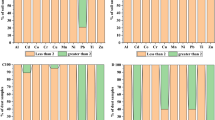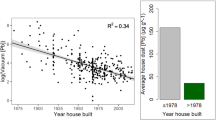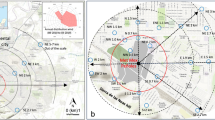Abstract
Ferroalloy production can release a number of metals into the environment, of which manganese (Mn) is of major concern. Other elements include lead, iron, zinc, copper, chromium, and cadmium. Mn exposure derived from settled dust and suspended aerosols can cause a variety of adverse neurological effects to chronically exposed individuals. To better estimate the current levels of exposure, this study quantified the metal levels in dust collected inside homes (n=85), outside homes (n=81), in attics (n=6), and in surface soil (n=252) in an area with historic ferroalloy production. Metals contained in indoor and outdoor dust samples were quantified using inductively coupled plasma optical emission spectroscopy, whereas attic and soil measurements were made with a X-ray fluorescence instrument. Mean Mn concentrations in soil (4600 μg/g) and indoor dust (870 μg/g) collected within 0.5 km of a plant exceeded levels previously found in suburban and urban areas, but did decrease outside 1.0 km to the upper end of background concentrations. Mn concentrations in attic dust were ~120 times larger than other indoor dust levels, consistent with historical emissions that yielded high airborne concentrations in the region. Considering the potential health effects that are associated with chronic Mn inhalation and ingestion exposure, remediation of soil near the plants and frequent, on-going hygiene indoors may decrease residential exposure and the likelihood of adverse health effects.
This is a preview of subscription content, access via your institution
Access options
Subscribe to this journal
Receive 6 print issues and online access
$259.00 per year
only $43.17 per issue
Buy this article
- Purchase on Springer Link
- Instant access to full article PDF
Prices may be subject to local taxes which are calculated during checkout




Similar content being viewed by others
References
Boudissa SM, Lambert J, Müller C, Kennedy G, Gareau L, Zayed J . Manganese concentrations in the soil and air in the vicinity of a closed manganese alloy production plant. Sci Total Environ 2006: 361: 67–72.
Menezes-Filho JA, Paes CR, de C Pontes ÂM, Moreira JC, Sarcinelli PN, Mergler D . High levels of hair manganese in children living in the vicinity of a ferro-manganese alloy production plant. Neurotoxicology 2009: 30: 1207–1213.
Harris AR, Davidson CI . The role of resuspended soil in lead flows in the California South Coast Air Basin. Environ Sci Technol 2005: 39: 7410–7415.
Young TM, Heeraman DA, Sirin G, Ashbaugh LL . Resuspension of soil as a source of airborne lead near industrial facilities and highways. Environ Sci Technol 2002: 36: 2484–2490.
USEPA Exposure Factors Handbook. US Environmental Protection Agency, National Center for Environmental Assessment, Office of Research and Development: Washington, DC, USA, 2011.
Aschner JL, Aschner M . Nutritional aspects of manganese homeostasis. Mol Aspects Med 2005: 26: 353–362.
ATSDR Toxicological Profile for Manganese. U.S. Department of Health and Human Services, Public Health Service: Atlanta, GA, USA, 2012.
Calne D, Chu N, Huang C, Lu C, Olanow W . Manganism and idiopathic parkinsonism: similarities and differences. Neurology 1994: 44: 1583–1586.
Lucchini RG, Albini E, Benedetti L, Borghesi S, Coccaglio R, Malara EC et al. High prevalence of Parkinsonian disorders associated to manganese exposure in the vicinities of ferroalloy industries. Am J Ind Med 2007: 50: 788–800.
Lucchini RG, Guazzetti S, Zoni S, Donna F, Peter S, Zacco A et al. Tremor, olfactory and motor changes in Italian adolescents exposed to historical ferro-manganese emission. Neurotoxicology 2012: 33: 687–696.
Lucchini RG, Martin CJ, Doney BC . From manganism to manganese-induced parkinsonism: a conceptual model based on the evolution of exposure. Neuromol Med 2009: 11: 311–321.
Martin CJ . Manganese neurotoxicity: connecting the dots along the continuum of dysfunction. Neurotoxicology 2006: 27: 347–349.
Menezes-Filho JA, Novaes CdO, Moreira JC, Sarcinelli PN, Mergler D . Elevated manganese and cognitive performance in school-aged children and their mothers. Environ Res 2011: 111: 156–163.
Mergler D, Huel G, Bowler R, Iregren A, Bélanger S, Baldwin M et al. Nervous system dysfunction among workers with long-term exposure to manganese. Environ Res 1994: 64: 151–180.
Moya J, Bearer CF, Etzel RA . Children’s behavior and physiology and how it affects exposure to environmental contaminants. Pediatrics 2004: 113: 996–1006.
Roels H, Ghyselen P, Buchet J, Ceulemans E, Lauwerys R . Assessment of the permissible exposure level to manganese in workers exposed to manganese dioxide dust. Br J Ind Med 1992: 49: 25–34.
Wang J, Huang C, Hwang Y, Chiang J, Lin J, Chen J . Manganese induced parkinsonism: an outbreak due to an unrepaired ventilation control system in a ferromanganese smelter. Br J Ind Med 1989: 46: 856–859.
Wright RO, Amarasiriwardena C, Woolf AD, Jim R, Bellinger C . Neuropsychological correlates of hair arsenic, manganese, and cadmium levels in school-age children residing near a hazardous waste site. Neurotoxicology 2006: 27: 210–216.
Lee J-W . Manganese intoxication. Arch Neurol 2000: 57: 597.
Olanow CW . Manganese‐induced parkinsonism and Parkinson's disease. Ann NY Acad Sci 2004: 1012: 209–223.
Zoni S, Bonetti G, Lucchini R . Olfactory functions at the intersection between environmental exposure to manganese and Parkinsonism. J Trace Elem Med Biol 2012: 26: 179–182.
Rentschler G, Covolo L, Ahmadi Haddad A, Lucchini RG, Zoni S, Broberg K . ATP13A2 (PARK9) polymorphisms influence the neurotoxic effects of manganese. Neurotoxicology 2012; 33: 697–702.
Borgese L, Federici S, Zacco A, Gianoncelli A, Rizzo L, Smith DR et al. Metal fractionation in soils and assessment of environmental contamination in Vallecamonica, Italy. Environ Sci Pollut Res 2013: 20: 5067–5075.
Kilbride C, Poole J, Hutchings T . A comparison of Cu, Pb, As, Cd, Zn, Fe, Ni and Mn determined by acid extraction/ICP–OES and ex situ field portable X-ray fluorescence analyses. Environ Pollut 2006: 143: 16–23.
Venables WN, Ripley BD . Modern Applied Statistics with S. Springer: New York, 2002.
Wood S Generalized additive models: an introduction with R. CRC Press: Boca Raton, FL, 2006.
Barceloux DG, Barceloux D . Manganese. Clin Toxicol 1999: 37: 293–307.
Zhao P, Feng Y, Zhu T, Wu J . Characterizations of resuspended dust in six cities of North China. Atmos Environ 2006: 40: 5807–5814.
Lenschow P, Abraham H-J, Kutzner K, Lutz M, Preuß J-D, Reichenbächer W . Some ideas about the sources of PM10. Atmos Environ 2001: 35: S23–S33.
Laidlaw MA, Filippelli GM . Resuspension of urban soils as a persistent source of lead poisoning in children: a review and new directions. Appl Geochem 2008: 23: 2021–2039.
Winder BS, Salmon AG, Marty MA . Inhalation of an essential metal: development of reference exposure levels for manganese. Regul Toxicol Pharmacol 2010: 57: 195–199.
Chattopadhyay G, KC-P Lin, Feitz AJ . Household dust metal levels in the Sydney metropolitan area. Environ Res 2003: 93: 301–307.
Rasmussen P, Subramanian K, Jessiman B . A multi-element profile of house dust in relation to exterior dust and soils in the city of Ottawa, Canada. Sci Total Environ 2001: 267: 125–140.
Tong ST, Lam KC . Home sweet home? A case study of household dust contamination in Hong Kong. Sci Total Environ 2000: 256: 115–123.
Crump KS . Manganese exposures in Toronto during use of the gasoline additive, methylcyclopentadienyl manganese tricarbonyl. J Expo Anal Environ Epidemiol 2000: 10: 227.
Lynam D, Roos J, Pfeifer G, Fort B, Pullin T . Environmental effects and exposures to manganese from use of methylcyclopentadienyl manganese tricarbonyl (MMT) in gasoline. Neurotoxicology 1999: 20: 145.
Lioy P, Freeman N, Wainman T, Stern AH, Boesch R, Howell T et al. Microenvironmental analysis of residential exposure to chromium‐laden wastes in and around New Jersey homes. Risk Anal 1992: 12: 287–299.
Ilacqua V, Freeman NC, Fagliano J, Lioy PJ . The historical record of air pollution as defined by attic dust. Atmos Environ 2003: 37: 2379–2389.
USEPA 2012. Integrated Risk Information System: Manganese; Available at http://www.epa.gov/iris/subst/0373.htm. Accessed 14 October 2013.
Acknowledgements
This study was originally supported by funding from the European Union through its Sixth Framework Program for RTD (contract no. FOOD-CT-2006- 016253). It reflects only the authors' views, and the European Commission is not liable for any use that may be made of the information contained therein. The project is now supported by Award Number R01ES019222 from the National Institute of Environmental Health Sciences. BTP was supported as a Post-Doctoral Research Fellow through the National Institutes of Health Training Grant 1T32ES019854-01 and the National Institute of Environmental Health Sciences CEED—2P30ES005022-21780309. We would like to acknowledge Tom Jursa for analytical assistance and Linda Everett for her help with GIS mapping.
Disclaimer
The content is solely the responsibility of the authors and does not necessarily represent the official views of the National Institute of Environmental Health Sciences or the National Institutes of Health.
Author information
Authors and Affiliations
Corresponding author
Ethics declarations
Competing interests
The authors declare no conflict of interest.
Rights and permissions
About this article
Cite this article
Pavilonis, B., Lioy, P., Guazzetti, S. et al. Manganese concentrations in soil and settled dust in an area with historic ferroalloy production. J Expo Sci Environ Epidemiol 25, 443–450 (2015). https://doi.org/10.1038/jes.2014.70
Received:
Accepted:
Published:
Issue Date:
DOI: https://doi.org/10.1038/jes.2014.70
Keywords
This article is cited by
-
AERMOD modeling of ambient manganese for residents living near a ferromanganese refinery in Marietta, OH, USA
Environmental Monitoring and Assessment (2021)
-
Assessing the contributions of metals in environmental media to exposure biomarkers in a region of ferroalloy industry
Journal of Exposure Science & Environmental Epidemiology (2019)
-
Airborne Emissions from Mn Ferroalloy Production
JOM (2019)
-
The health hazards of potentially toxic metals in the daily diets of adults and children from a mining and smelting region (Hezhang County) in southwestern China
Environmental Monitoring and Assessment (2018)
-
Long-term Geochemical Evolution of Lithogenic Versus Anthropogenic Distribution of Macro and Trace Elements in Household Attic Dust
Archives of Environmental Contamination and Toxicology (2017)



